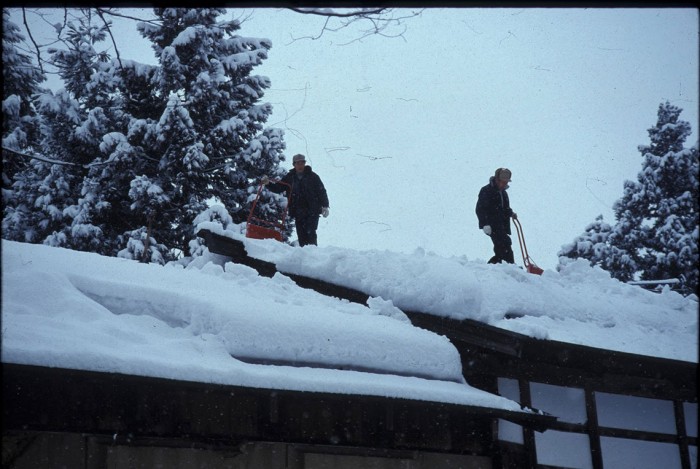
Among the many images of the 1950s held by elderly Japanese people today are those of school-leavers boarding trains for the cities. This image is not just that of one family wishing farewell to a son or daughter, but of a whole village turning out to wave good-bye to a newly graduated middle school or high school class. Times were still hard after the war, especially in rural areas which were slow to receive the benefits of economic growth. Newly booming industries in Tokyo, Osaka and Nagoya were desperate for labor – to the extent that recruiters were sent into the rural schools to seek fresh-faced school leavers with the promise of opportunities never imagined by farm families. The farmers themselves were still flushed with the new opportunities offered by the post-war land reform which put land ownership in their hands and were happy to see their children take-up these exciting new work prospects.
For a few years the benefits of this youthful rural exodus seemed fine. Mechanization of farmwork meant that the young people were not needed in the fields. Health improvements meant everyone was living longer, and that children no longer had to stay around just in case the farm needed ‘taking over’ when a parent died. The 1946 Constitution implied that young adults were free to choose their own careers anyway, and that farm inheritance would now be based on equal division rather than passing all to the eldest son, as tradition dictated. Parents waving their children good-bye at those small rail stations were glad that a better economic environment awaited their offspring than that which they themselves had endured in the grim pre-war years. After all, perhaps their eldest sons could send a few yen home now and then, to help out, just in case.
By the mid-1960s there was no stopping the rural exodus. Younger brothers and sisters, who could now experience the allure of city life through TV and radio, as well as letters home, needed little persuasion to get on the city-bound train as soon as they left school. Memories of the 1963 heavy snowfall along the western half of the country had, in any case, already persuaded them that life in the rural areas was only for those who sought hardship – the cities were warm, glowing, and free of snow. This was also the time when the national income was doubling, and everyone knew that the extra cash was in the urban areas, and not on the farms. Anyway, their elder brothers had already gone and their parents lived on. Why shouldn’t they go?
Farmers were beginning to enjoy the labor-savings brought about by new machines, such as the rice-harvester, and the high prices government offered for their rice. Despite their ever improving standard of living, however, they began to suffer doubts about their futures. Eldest sons were now finding their own partners for marriage, and they were not returning to the villages. Grand-children were being born in the cities, and going to city schools. There were no children in the village schools, and they began to shut down for lack of numbers. Families with young children who had remained in the villages moved out to towns and cities where new schools were being built. Bus services to the villages lost customers and began to suspend operations. Old folks no longer could rely on younger people to be around them and help care for their needs. Within the space of two decades the rural exodus had cut the life support for many rural communities. By the mid-1970s almost 300 villages had already ‘died’, being completely abandoned as a result of rural depopulation.

The ‘oil crisis’ of 1972 seemed to bring an end to the rural exodus. Lack of fuel meant that the cities lost their alluring glow. The truth is that most eldest sons had already bought a one-way train ticket to life-long employment in the city. Other sons and daughters had also followed. Agriculture in Japan is now carried on by people in their sixties and seventies. Further improvements in farm mechanization have helped, particularly the development of the rice transplanter in the 1970s. Life expectancy in Japan is currently higher than anywhere else in the world. At present, farmers still manage to operate their fields and forests without the help of their sons. As the year 2000 approached, however, the survival of many thousands of villages cotinued to be uncertain. The old people will soon die and there are few young people willing or able to move back to the countryside. Even prosperous villages such as Tsumago in the Kiso River Valley have serious problems related to changes in the nation’s demography. In 1998, the local primary school closed because of the falling birth rate. Some young people are returning to the village, but the closure of the school must raise questions in the minds of others who are considering staying in the village or returning from large cities like Nagoya.

Rice transplanter

